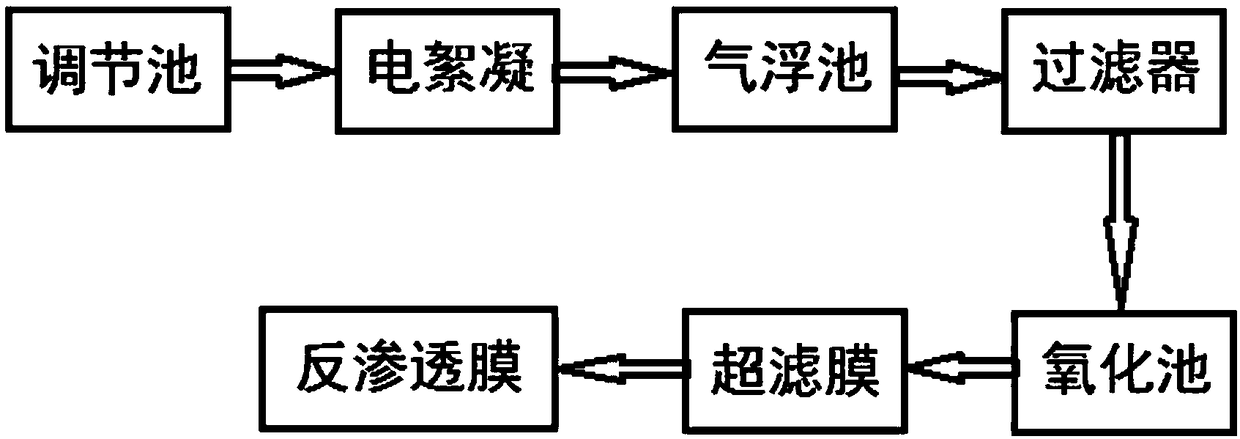Treatment method for acrylonitrile wastewater
A technology for the treatment of acrylonitrile wastewater, which is applied in water/sewage treatment, natural water treatment, flotation water/sewage treatment, etc., and can solve problems such as long start-up time, increased cost of treatment chemicals, and increased ion concentration of wastewater. Achieve the effects of strong impact resistance to wastewater concentration fluctuations, support for sustainable development, and considerable economic benefits
- Summary
- Abstract
- Description
- Claims
- Application Information
AI Technical Summary
Problems solved by technology
Method used
Image
Examples
Embodiment 1
[0036] See figure 1 . A method for treating acrylonitrile wastewater, including the following steps:
[0037] (1) The treated acrylonitrile wastewater is the wastewater produced during the process of propylene ammoxidation to produce acrylonitrile. The main pollutants and concentration ranges in the wastewater are: COD: 1200~3000mg / L; TKN: 200~500mg / L; NH3 -N: 100~250mg / L; TCN: 30~100mg / L.
[0038] The acrylonitrile wastewater is adjusted to pH 6.5 with sulfuric acid or sodium hydroxide and then sent to an adjustment tank equipped with a paddle agitator or jet agitator, and the wastewater is homogenized and uniformly mixed. The wastewater stays in the adjustment tank At least 4 hours.
[0039] (2) The waste water after the uniformity and quantity adjustment of the adjustment tank is sent to the electro-flocculation device for adjustment treatment: the anode of the electro-flocculation device is a rod-shaped material made of aluminum, and the cathode of the electro-flocculation dev...
Embodiment 2
[0050] Follow figure 1 . A method for treating acrylonitrile wastewater, including the following steps:
[0051] (1) The treated acrylonitrile wastewater is the wastewater generated during the process of propylene ammoxidation to produce acrylonitrile (same as Example 1).
[0052] The acrylonitrile wastewater is adjusted to pH 8.5 with sulfuric acid or sodium hydroxide, and then sent to an adjustment tank equipped with a paddle agitator or jet agitator, and the wastewater is homogenized and uniformly mixed. The wastewater stays in the adjustment tank At least 4 hours.
[0053] (2) The waste water after the uniformity and quantity adjustment of the adjustment tank is sent to the electro-flocculation device for adjustment treatment: the anode of the electro-flocculation device is a plate material made of iron, and the cathode of the electro-flocculation device is made of iron For plate-shaped materials, the concentration range of iron ions produced by the electric flocculation devic...
Embodiment 3
[0061] See you again figure 1 . A method for treating acrylonitrile wastewater, including the following steps:
[0062] (1) The treated acrylonitrile wastewater is the wastewater generated during the process of propylene ammoxidation to produce acrylonitrile (same as Example 1).
[0063] The acrylonitrile wastewater is adjusted to pH 7.5 with sulfuric acid or sodium hydroxide and then sent to an adjustment tank equipped with a paddle stirrer or jet agitator, and the wastewater is homogenized and uniformly mixed. The wastewater stays in the adjustment tank At least 4 hours.
[0064] (2) The waste water after the uniformity and quantity adjustment of the conditioning tank is sent to the electro-flocculation device for adjustment treatment: the anode of the electro-flocculation device is a plate material made of aluminum, and the cathode of the electro-flocculation device is made of carbon Rod-shaped material, the concentration range of aluminum ions produced by the electric floccula...
PUM
| Property | Measurement | Unit |
|---|---|---|
| Filter pore size | aaaaa | aaaaa |
| Recovery rate | aaaaa | aaaaa |
Abstract
Description
Claims
Application Information
 Login to View More
Login to View More - R&D Engineer
- R&D Manager
- IP Professional
- Industry Leading Data Capabilities
- Powerful AI technology
- Patent DNA Extraction
Browse by: Latest US Patents, China's latest patents, Technical Efficacy Thesaurus, Application Domain, Technology Topic, Popular Technical Reports.
© 2024 PatSnap. All rights reserved.Legal|Privacy policy|Modern Slavery Act Transparency Statement|Sitemap|About US| Contact US: help@patsnap.com








